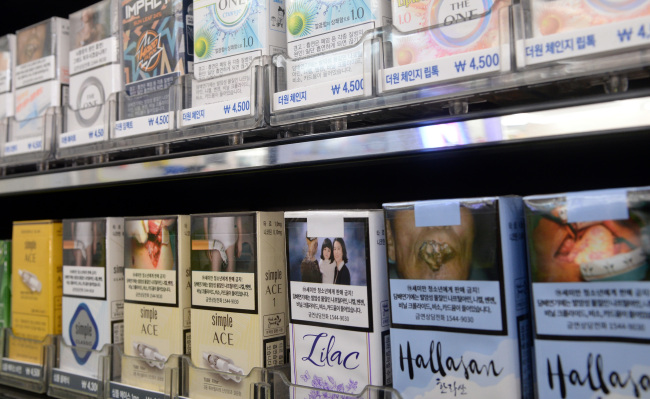Sung Jong-tae, 35, a heavy smoker for the past 15 years, has tried almost everything there is to quit smoking, but his efforts have been in vain.
“I am well aware, more than anybody else, of the detrimental effects of smoking, having a 3-year-old daughter at home. But still, nothing can physically help me stop smoking,” Sung told The Korea Herald.
Even the recently introduced disturbing graphic warnings on cigarette packs have not helped him kick the habit.
“These graphics, though quite terrifying as they are, can easily be covered with my fingers,” Sung said.
“Also, I don’t really think about them when placing a cigarette in my mouth.”
 |
Cigarette packs are lined up on a shelf in a convenience store in Seoul. About half of them do not carry graphic warnings yet due to production and distribution procedures. (Park Hyun-koo/The Korea Herald) |
Two months have passed since the government introduced mandatory graphic warnings as part of efforts to curb smoking, but many are questioning its effectiveness.
The ministry designated in December that all cigarette packs sold here, including those sold at duty-free shops, must carry one of 10 designated full-color photos showing graphic images and warnings on the harmful effects of smoking.
Some of the photos depict the body parts of smokers suffering from fatal diseases such as lung cancer, oral cancer, heart attacks and strokes.
This was the first time since 1986 that the government started using visual images on cigarette packs as part of its anti-smoking campaign. Korean cigarette packs had previously only carried text warnings.
But despite the government’s expectations that the altered cigarette packs would pull down the smoking rate by 4.7 percent on-year, cigarette sales early this year have already surpassed the corresponding period for last year.
According to the Ministry of Health and Welfare, the amount of cigarette packs sold hit 280 million packs in January alone, up 4.9 percent from the 267 million packs sold in the same period in 2016.
Industry insiders say cigarette sales may record an upward trend in the second quarter of this year.
“Following New Year’s resolutions, most smokers tend to decide to give up smoking, which lead to relatively low sales from January to March,” said an official from the country’s leading tobacco maker KT&G.
“It is the sales volume in April-June that one should really look into, in order to find the actual effect of the graphic warnings on the cigarette packs,” he added.
However, smokers say the graphic warnings will not be able to help them quit.
Lee Jung-nam, who runs a convenience store in the crowded district of Gwanghwamun, finds that the disturbing photos have little impact.
“There seems to be little difference among smokers -- and even myself as a seller and a smoker -- when purchasing the cigarette packs with the altered design. (The photos) are not really noticeable, and many smokers already have a box case to put cigarettes inside and throw away the package right away,” Lee told The Korea Herald.
“I heard that some convenience shop owners are putting papers and covers in front of shelves to hide the graphic warnings on cigarette packs,” he added.
According to Lee, the disturbing photos on the packs simply results in more smokers using cigarette cases.
On blogs and online communities, smokers have uploaded their brand new cigarette cases, from plastic cases to pricey leather case, actively sharing information on where to get them.
According to Ebay Korea, sales of cigarette cases at e-commerce marketplace Auction rose sevenfold in January alone, compared to the same month last year.
Currently, the action of hiding graphic warnings on cigarette packs on purpose cannot be punished by law.
Earlier this month, 11 lawmakers including Rep. Kim Seung-hee of the ruling Liberty Korea Party proposed a revision to the National Health Promotion Act, so shops who intentionally hide graphic warnings on cigarette packs would be punished by law and fined.
The ministry is also moving to revise the current regulation on the graphic warnings.
“I think it is little hasty to be looking at the results of the graphic warnings attached on the cigarette packs, since products with the altered design have not even been fully distributed to stores across the country (yet),” said a ministry official from the national health promotion division.
“Unlike sharp hikes in tobacco prices, the graphic warnings are meant to change people’s way of thinking and mindsets, which may take a longer period of time to result in an actual fall in the smoking rate.
“But if necessary, the ministry will discuss the size of the graphic warnings and expand them to become more noticeable by revising the current law,” he added.
For now, the graphic health warnings must be placed on the upper part of both sides of cigarette packets. The photos are required to cover more than 30 percent of both sides of each packet, the ministry said.
Under the law, the graphics will be replaced every 24 months and a notice about the next 10 photos will be announced six months ahead of the replacement. Violators of the law will face up to a year in jail or up to 10 million won ($12,000) in fines, or revocation of the company’s business license.
Anti-smoking campaigns that use such visual images were first introduced in Canada in 2001. Such practices are currently adopted by 101 countries around the world.
By Kim Da-sol (
ddd@heraldcorp.com)








![[Today’s K-pop] Blackpink’s Jennie, Lisa invited to Coachella as solo acts](http://res.heraldm.com/phpwas/restmb_idxmake.php?idx=644&simg=/content/image/2024/11/21/20241121050099_0.jpg)